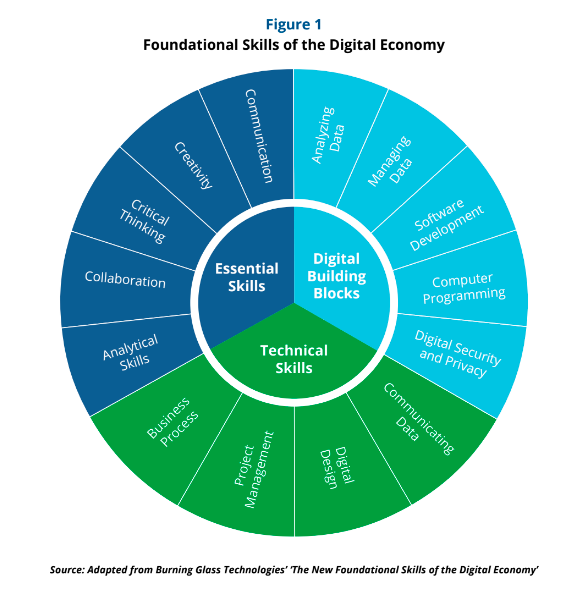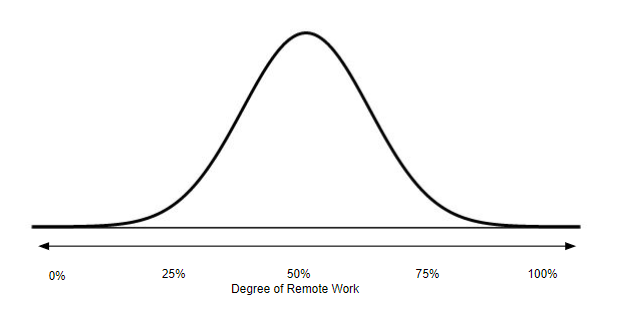In our 2020 Future of Work blog series, we talked about how companies were trying to figure out how to keep their doors open and their staff healthy by embracing remote work.
Many organizations had avoided remote work policies for their employees in the past due to three critical beliefs about remote work:
- Far too costly to implement
- Detrimental effect on productivity
- Policies would have to be “all-or-nothing” either allowing employees to only work remote or only be in the office 100% of the time
The COVID-19 pandemic forced businesses to either shut down or figure out how to manage points one and two. And point three was a foregone conclusion. Due to the pandemic, most companies had to quickly adjust to figure out how to equip as many employees as possible work from home. So, metaphorically, the pandemic took organizations and threw them into the deep end of the pool and urged them to figure out how to swim using remote work as flotation devices. Organizations are now starting to decide how to proceed when the pandemic is no longer forcing them to doggy paddle for survival.
Organizations went beyond just extending work-from-home policies. At least twenty-three major companies have made remote work a permanent part of their workforce strategies. Additionally, corporate and residential real estate are seeing changes in their markets related to the shift to remote work. For example, REI bought a new corporate headquarters and has sold it off before even moving in to set up smaller, satellite offices for a remote workforce. From a residential perspective, people are moving to more suburban areas where properties are cheaper and larger–to accommodate home offices and home gyms–while properties in urban sprawls are facing falling values and apartments are sitting empty.
So, we’re still at the beginning of 2021, and our healthcare system is delivering COVID-19 vaccines, but most of us are probably going to be without them until Spring. And we’re unlikely to see “back to normal” until about the end of Q3 or the end of 2021. As mentioned in the last article, we’re probably going to see a modern version of the roaring 20s as individuals gain more confidence that we can go out and do many of the same things we used to do. But that’s probably months away based on all the information and that’s driving organizations to keep remote work settings in place.
But, there’s now more than just COVID shifting companies to embrace more and more remote work. We engaged in research with FlexJobs showing that remote work jobs, such as computer programming and IT positions and even many in the medical and healthcare field are on the rise. And developing new skills such as Service Orientation, Social Awareness and Conflict Management will help you get those jobs. With the increase in remote job roles that FlexJobs identified comes the need for more digital literacy skills shown below. (Sidenote: To learn more about how PAIRIN can help develop these skills, check out our online skills curriculum)

Because the pandemic forced almost every organization to embrace remote work to one degree or another, those looking at how people work have begun to realize that we can’t just look at “jobs” anymore. We need to look at how tasks are structured. In research presented by McKinsey, they surfaced evidence that task performance is contextual and may differ across jobs and lead to remote work potentials. The virus punched through the cognitive barriers the business world espoused about remote work and has forced organizations to think critically about where work needs to take place. Specifically, we have to look at the context of a task to determine if that task can be performed remotely or not. For example, consider the task of “Training, teaching, coaching and developing others.” A person training college students could perform this task remotely, but a person training food-service workers may not be able to. And this structural challenge runs through almost every job.
This new view drives the future for remote work in most organizations and references point three above supporting the fact that remote work doesn’t have to be an “all-or-nothing” proposition. Many organizations are looking at McKinsey’s work, evaluating positions and making decisions about the degree to which employees might do some remote work. The key takeaway is that remote work will not continue to be at the same level as it has been during the height of the COVID-19 pandemic, but it is likely to be here to stay in many industries. A more granular examination of the tasks necessary to perform a job and the specific context required for each task leads to a strong belief that hybrid models of remote work will take hold. This hybrid model is defined as where employees will perform some parts of their work from home offices and will also have the components necessary to perform on-site at brick and mortar locations as needed.

There is a concept in probability theory called the “Central Limit Theorem.” This concept essentially states that perfect dichotomies (e.g., black and white) are very rare, and most things exist on a normal curve where the extremes are very rare, and some mix of grey is in the middle. I believe that this is a good metaphor for what the future of remote work holds.
In the future, as the world returns to normal and the pendulum swings again, we may not have a perfectly normal distribution, but it will likely be more balanced than before the pandemic hit.
Overall, the one thing that all sources tend to agree on is that remote work is here to stay!
Before the pandemic, most organizations believed that remote work was too costly to implement, remote employees couldn’t be as productive as onsite employees, and that their only options were to have “all-or-nothing” policies. With the pandemic, those that could function remotely were forced to find ways to implement and maintain remote practices at length. As a result, these organizations “learned to swim” in the deep end of the pool and to their surprise, have found that swimming is good for them. So to quote a famous fish, “Just keep swimming!”
